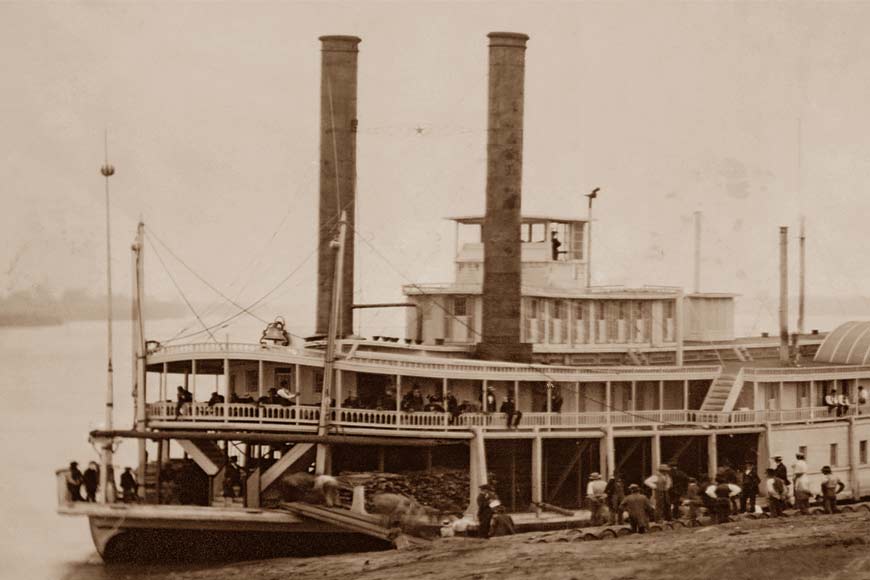Steamships of British Bengal: symbolizing the progress of man and his mastery of nature - GetBengal story

Representative Image
Since time immemorial, boats on the Hooghly, from the simplest canoe made from the hollowed-out-trunk of a tree too the stately gold decorated barges, had been propelled by wind, rowed or dragged along the riverbank. During the rainy season, favourable winds made it possible to sail upriver, as long as the downward current wasn’t too strong; when the winds failed, or the current became too much, little choice existed but to moor and wait. The dangers of navigation made it fool-hardy to travel at night. As such, progress upriver was very slow; at the start of the 19th century, the journey from Calcutta to Allahabad on the Hooghly and the Ganges averaged from 3-4 months. Travelling down river was quicker – the return trip could be as short as 20 days, but also more dangerous. ‘Boats are absolutely whirled along,’ wrote one English traveller and ‘if while forced at an almost inconceivable rate by the impetuosity of the current, they should strike again the keel of a former wreck or come in contact with some of the numerous trees and other huge fragments, victims of the devouring wave, destruction is inevitable. The boat sinks at once, and the crew and passengers have little chance of escaping with their lives, unless at the moment of the concussion they jump into the river and are able to swim to shore.’
Built by the Howrah Docks Company, the Hooghly was a teakwood vessel, 102 feet long and 18 feet broad with two fifty horse power engines. Its flat bottom was specifically designed with the shallowness of the Hooghly in mind. In September 1828, the Hooghly departed for Allahabad on the first steam ship expedition on the river above Calcutta.
Collisions were a common occurrence when boats were forced together by the strength of tides and currents. The arrival of steam technology in Bengal promised to change radically the nature of transport on the river. In Britain and America, experiments with the use of steam to propel boats had begun in the late 1700s and by the second decade of the 19th century steam navigation was becoming commonplace. An initial scheme to introduce steamers to India was formulated in 1812; the American engineer and steam pioneer Robert Fulton argued that steamboats would be of incalculable commercial and military value to the East India Company. At first the Company’s directors were skeptical but in time they along with official and private parties in Bengal began to extol the advantages of steam. The technology would make river transportation in Bengal faster and easier freeing it form the uncertainties of wind, current and tide.
In British minds steam became synonymous with civilization. Steam technology symbolized the progress of man and his mastery of nature. Steam navigation would deliver this progress to India exposing new parts of the country to the civilizing influence of British rule. Thomas Prinsep, captain of one of the first steam ships in Bengal was convinced that steam power would promote the convenience and increase the powers of mankind diffusing over the world an activity the effect of which in extending the power of civilization the most sanguine would not venture to prophecy. In 1823, a new steam navigation company was formed in Britain with the support of European capital from Calcutta. It financed the construction of the Enterprise, a 60-horse power vessel that made the inaugural steam journey around the Cape of Good Hope to India arriving at Calcutta in late 1825. The length of the journey disappointed investors at 114 days but a breakthrough had been made. Over the next couple of years, two further steam boats, The Emulous and Telica were built in Britain and sent out to Bengal. Simultaneously, the construction of steam vessels on the Hooghly at the shipyards of Khidderpore and Howrah got underway. The Diana was a modest 32 horsepower vessel sent on trial voyages in the waterways of East Bengal before being sold to government for use in the First Burmese War in 1824. The Forbes was employed as a tug from Calcutta to Diamond Harbour; the Irrawady and Ganges were used for transporting troops and supplies from Calcutta to Chittagong and Rangoon. The design of these early vessels were far from satisfactory. The engines of the Irrawady and Ganges for example drew too much water and were ineffective against headwinds and strong currents. But for the advocates of steam there were successes too when the Forbes completed a voyage to China. The Royal Charter for a regular steamer service between Britain and India was awarded to the Peninsular and Oriental Steam Navigation Company. Within a few years the attention of the Bengal government turned to the use of steam for inland river navigation. With its patronage two new vessels were assembled for the purpose – The Burhampootur and The Hooghly.
Built by the Howrah Docks Company, the Hooghly was a teakwood vessel, 102 feet long and 18 feet broad with two fifty horse power engines. Its flat bottom was specifically designed with the shallowness of the Hooghly in mind. In September 1828, the Hooghly departed for Allahabad on the first steam ship expedition on the river above Calcutta. The challenges faced were immense. The use of steamers for river navigation had proven successful in America where the rivers were broad and deep and fuel were available in abundance, the Hooghly and the Ganges were the opposite. Coal had to be sent in advance to the main stations on the route – Murshidabad, Rajmahal, Patna, Ghazipur and Benares. Local parties knowledgeable about the rivers’ currents and depths were sourced to help with the navigation.
In 1823, a new steam navigation company was formed in Britain with the support of European capital from Calcutta. It financed the construction of the Enterprise, a 60-horse power vessel that made the inaugural steam journey around the Cape of Good Hope to India arriving at Calcutta in late 1825. The length of the journey disappointed investors at 114 days but a breakthrough had been made. Over the next couple of years, two further steam boats, The Emulous and Telica were built in Britain and sent out to Bengal.
Twice the Hooghly got stuck on sand banks, more seriously near Allahabad. But ultimately the voyage was a success. The 800 miles negotiated in 240 hours under steam on the outbound leg and 120 on the return with the river’s surveyed enroute. An indication of the growing British confidence in steam navigation on the Hooghly is provided by the launch of a regular government steamer service between Calcutta and Allahabad in 1834. By this point the average journey time on the outbound lake had been cut to about three weeks. In the next decade it would fall as low as 10 days. Each steamer service consisted of a steam boat towing a second vessel known as a flat. The steam boat housed the engines and carried fuel, as well as providing quarters for officers. The flat accommodated passengers and freight. The demand for freight carriage was high particularly when roads were impassable during the rains, the government shipped its own arms, money and supplies and auctioned the space that remained. The volume of shipping and tonnage of goods transported by the river’s steam service rose steadily, though the role of cheaper and more numerous country boats in the transport of goods and people were not eclipsed. By 1840 the government had 10 river going steam vessels on its books.
(Adapted from Hooghly – The Global History of a River)










